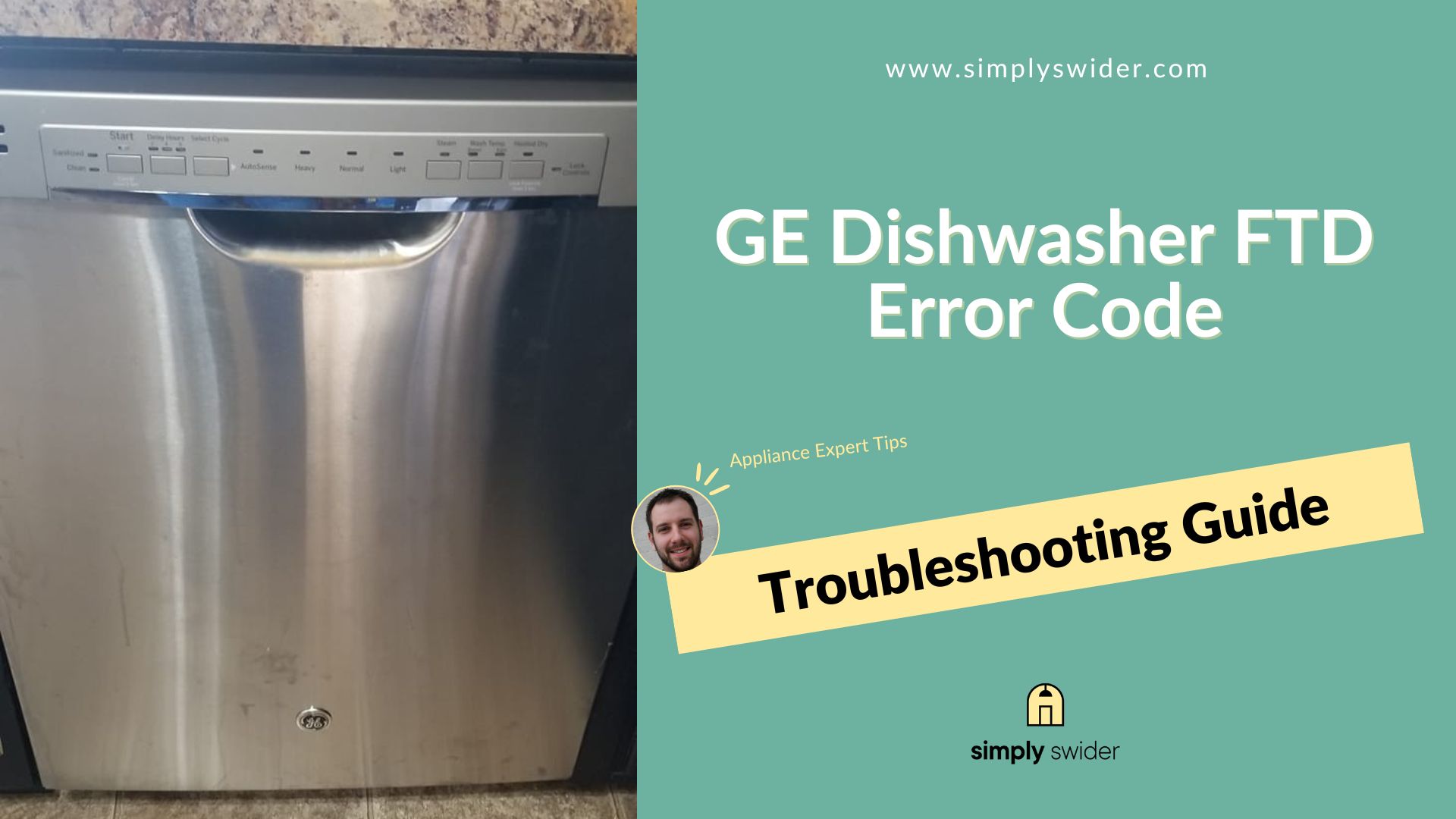Ever been stopped in your tracks by the FTD error code on your GE dishwasher? I have. Multiple times.
Let me tell you:
There’s nothing more unsettling than seeing an error code and not having a clue what it means. It’s like the machine’s trying to communicate, but you just can’t understand the language.
So, here’s the deal:
While these codes are indeed vital diagnostic tools, they’re often cryptic. But guess what? I’ve dedicated my career to decoding them. And for this one, I’ve teamed up with Mike Baron, a seasoned appliance technician from sunny Florida.
Together, we’ll break down the FTD error mystery and guide you on setting things right.
Let’s dive in, shall we?
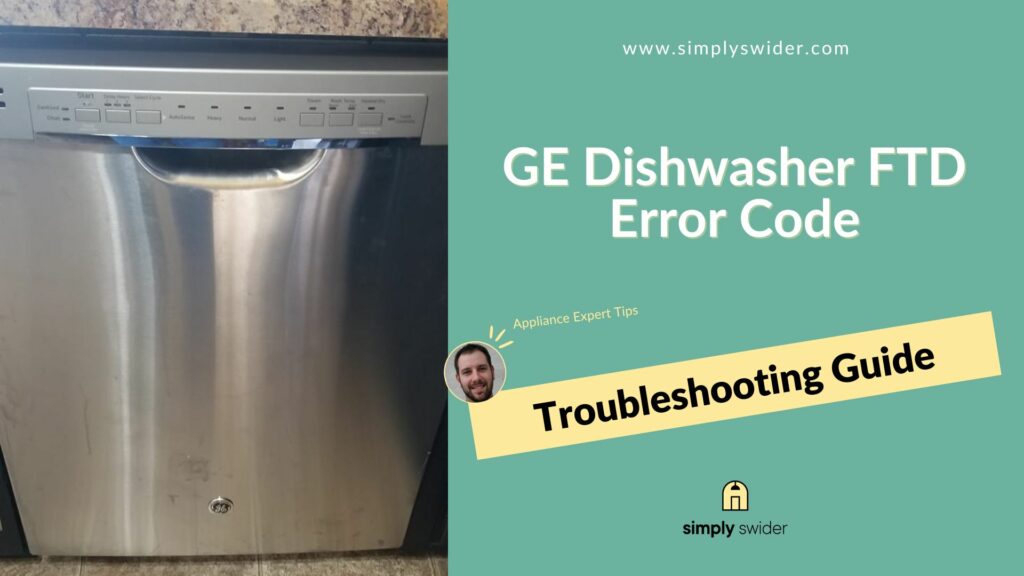
Table of Contents
What is the FTD Error Code?
Simply put, as per GE Appliances, FTD stands for “Failure to Drain.” And trust me, it’s more than just a drain pump or pressure sensor issue. I’ve seen kinked drain hoses and clogged sump filters causing just as much trouble.
But here’s the thing:
This guide will dive deep into these culprits and offer hands-on troubleshooting advice.
Ready?
Turn off your dishwasher, shut the water supply, and let’s tackle this together!
4 Common Causes & Quick Fixes!
| Commonly Affected Parts | Estimated Cost |
|---|---|
| Drain pump | $35 – $150 |
| Drain hose | $14 – $50 |
| Sump filter | $19 – $41 |
| Pressure sensor | $17 – $60 |
1. Faulty Drain Pump
| Part | Drain pump |
| Location | It is located at the bottom of the dishwasher, close to the rear. |
| Ease of troubleshooting | Moderate |
| Cost | $35 – $150 |
| Repairable | Yes – if it is clogged No – if it is damaged or has motor issues |
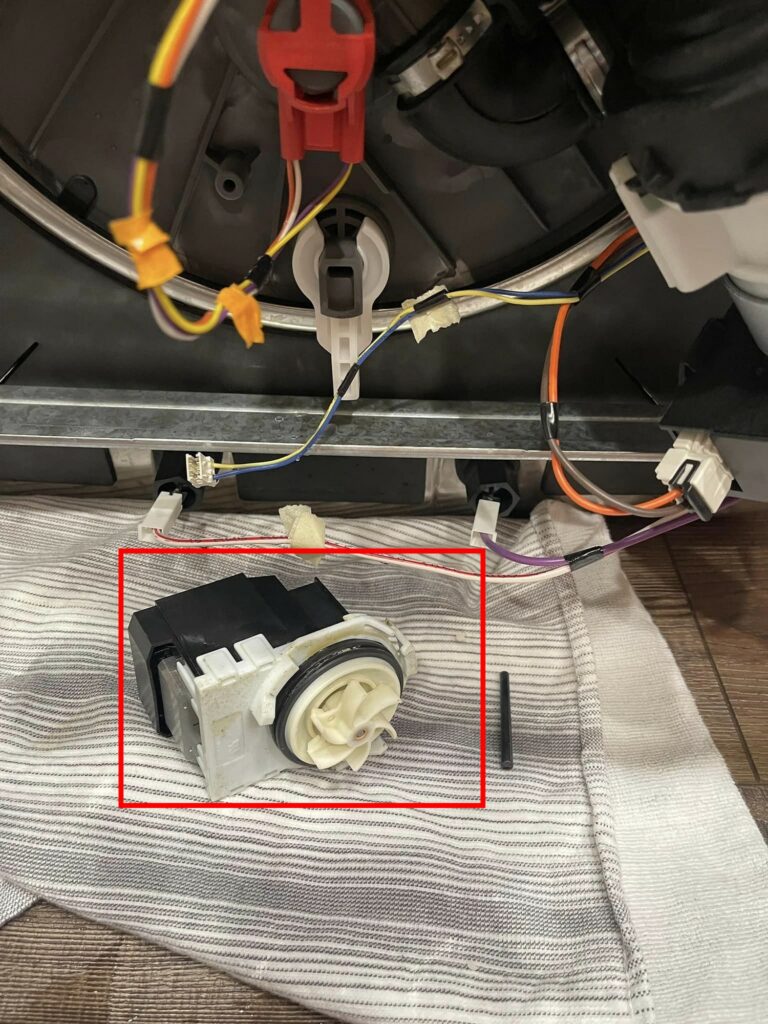
Problem:
While the H20 error code on your GE dishwasher denotes a water supply issue, the FTD error code identifies a drainage complication.
So, I’ve got a question for you.
What component comes to mind when you think of your dishwasher’s drainage system? All answers are correct, but the drain pump is the most critical component to look out for.
As such:
You must inspect it for faults. You see, sometimes food particles, broken ceramics, and built-up mineral compounds could cause a clog in the pump, setting off the FTD code.
Furthermore:
The motor that powers the drain pump impeller could have worn out or gotten damaged, leading to an electrical failure.
That’s what happened to this Reddit user whose GE PDT785SYNFS Profile Dishwasher displayed the FTD error code.
Identification:
It’s your turn to ask the questions now. And you’re probably wondering, “How can I tell whether the drain pump is faulty?”
Good question!
Beyond the FTD code, the drain pump is likely faulty if you observe pungent, stagnant water pooling in your dishwasher after a cycle.
Mike adds:
“If your dishwasher shuts off without completing the drain cycle, then there is a high chance the drain pump is bad.”
Solution:
What now?
The only way to confirm is by accessing the drain pump.
So, unscrew and detach the bottom access panel, locate the drain pump, unthread the wiring, and remove it from the dishwasher.
Next:
Check for foreign objects lodged in the component and clear out any debris. Then, manually spin the impeller to be sure it is not jammed.
Finally:
Test it for continuity with a multimeter. If it fails this test, replace the drain pump assembly immediately.
2. Clogged or Kinked Drain Hose
| Part | Drain hose |
| Location | It is connected to the drain pump behind the dishwasher. It also passes through the cabinet and is attached to the sink drain line or garbage disposal. |
| Ease of troubleshooting | Easy |
| Cost | $14 – $50 |
| Repairable | Yes – if it is clogged or kinked No – if it is extensively damaged |
Problem:
The drain hose is designed to channel wastewater from the dishwasher. Hence, if it is bent at an awkward angle or clogged with debris, your dishwasher will have trouble passing water out.
You see:
Barely two hours after installing his GE PDP755SYR4FS Profile Dishwasher, this Reddit user was greeted by the FTD error code. It actually showed up as “FED” for him.
Identification:
When he tried to run the drain cycle, the machine stopped abruptly.
From discussions in our Facebook community, it’s apparent that this is a common symptom of a problematic drainage system.
Mike weighs in:
“You may also notice that your dishwasher spends more time in a cycle and might not drain completely. This is because the crease or clog in the hose is impeding the flow of water.”
Solution:
If you notice any of these symptoms, you’ll need to straighten and unclog your drain hose.
Remove the mounting bracket screws and gently pull the dishwasher out of the cabinet. Once you have accessed the drain hose, inspect it for kinks and clogs.
Now:
If you notice creases, straighten them, ensuring the hose is elevated above its connection point to the garbage disposal or drain line.
You’ll need to flush the drain hose with a pressure washer or use a pipe cleaner to dislodge the debris for clogs.
However:
In the event of serious blockages, you should consider replacing the drain hose entirely. After troubleshooting, run a test cycle to be sure you’ve solved the problem.
3. Blocked Dishwasher Sump Filter
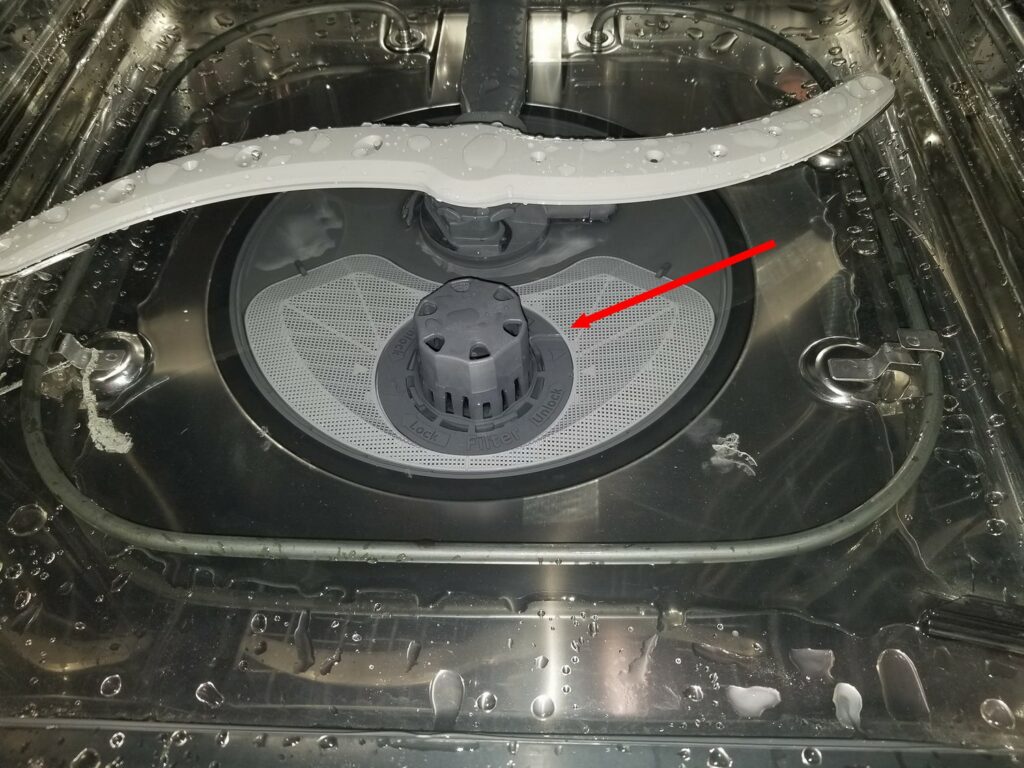
| Part | Sump filter |
| Location | It can be found at the bottom of the dishwasher, beneath the lower spray arm. |
| Ease of troubleshooting | Easy |
| Cost | $19 – $41 |
| Repairable | Yes – if it is clogged No – if it has deteriorated beyond repair |
Problem:
Before the wastewater is passed through the pump and out the drain hose, it has to go through the sump filter.
The sump filter catches food bits or other small objects that could pass through the drain and cause a blockage.
However:
With time, even the filter could get clogged if not cleaned regularly. And guess what error code will show up on your display? The FTD error code.
Identification:
If you notice standing water in your dishwasher tub or slow drainage, the sump filter is likely clogged with debris.
You could also discover water backing up the kitchen sink, accompanied by gurgling sounds.
Solution:
Any issue with your sump filter is bound to have compounded over a stretch of time. This is why I recommend cleaning the filter every month or two.
Here’s what you need to do:
Open your dishwasher, detach the bottom rack, and inspect the Fine and Ultra Fine filters in the sump area. Remove them and clean them carefully with a sponge.
In GE Appliance guidelines, the company advises against scrubbing with scouring pads or brushes as they can damage the filter surface.
Mike chips in:
“You must ensure you scrape leftovers off your plate before chucking it in the dishwasher to avoid clogging your drain filter.”
Similarly, this Reddit user was advised to stop leaving chunks of food in their GE Adora DDT700SSN4SS Dishwasher as a remedy for the FTD code.
As a preventive measure:
I suggest you examine the filter after each wash, making sure to wipe off any collections with a damp dishcloth.
4. Defective or Clogged Pressure Sensor
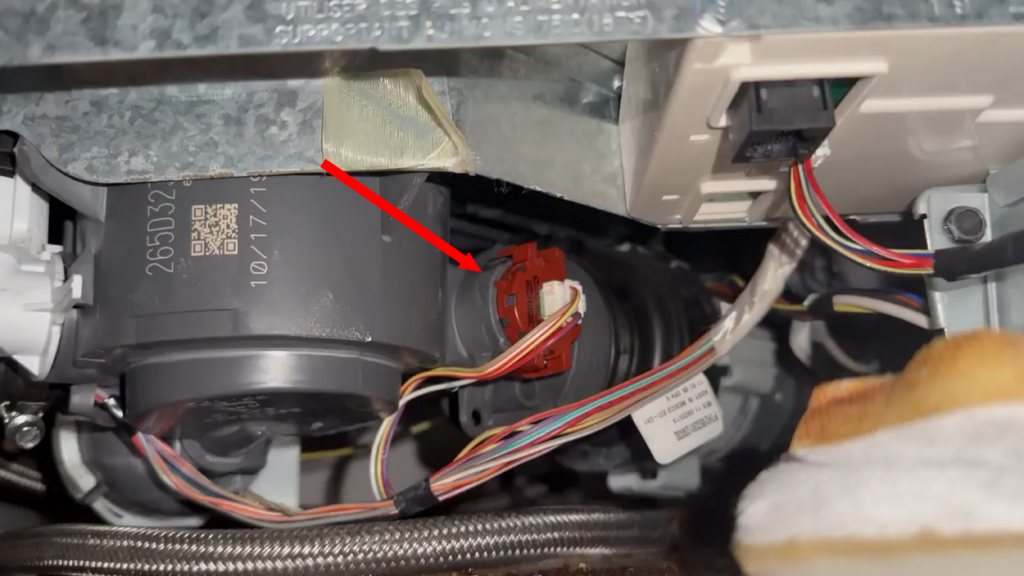
| Part | Pressure sensor |
| Location | It is situated close to the drain pump, near the sump area in the dishwasher. |
| Ease of troubleshooting | Moderate |
| Cost | $17 – $60 |
| Repairable | Yes – if it is clogged No – if it is malfunctioning |
Problem:
The pressure sensor detects the water level in your dishwasher and sends a signal to the control module that regulates the water supply and discharge.
A defective pressure sensor will not be able to transmit the signal necessary to drain the dishwasher.
Often:
The pressure sensor accumulates gunk, stopping it from doing its best work. Other times, it fails electrically.
Identification:
Typically, when the pressure sensor is bad, the dishwasher will not complete its drain cycle.
Even worse, it may not know when to begin or end.
Solution:
This Reddit user’s GE GDT630PYM5FS Dishwasher was throwing the FTD code at the beginning of the wash cycle. But,what was puzzling was that it was draining normally.
In response:
A user in the discussion suggested cleaning out the clog in the pressure sensor. Thankfully, that did the trick.
Comparatively:
Another Reddit user’s GE GDT530PSP5SS Dishwasher producing the FTD error code needed more than a quick clean to solve his problem.
You see:
After unclogging the pressure sensor, he was plagued with more complications. And eventually, he had to replace it.
In light of this:
You must know how to unclog and replace a defective pressure switch.
So, detach the bottom access panel, locate the pressure switch and check that the wiring is appropriately connected.
Then:
Examine it for any foreign objects or debris, and gently but meticulously clean them out.
Next, test the pressure sensor for electrical continuity with a multimeter if cleaning does not resolve the issue.
Note:
If it fails this test, you must replace the part immediately. Remember that you can get authentic replacement parts from the GE parts store.
Models Most Affected
Get this:
The FTD error code is prevalent in several GE dishwasher models.
Various design and manufacturing decisions put these models at the receiving end of the drainage issues triggering the error code.
In any case:
Below, I have highlighted the models, their model numbers, and why they typically display the FTP error code.
| Model Number | Model Name | Specific Reason |
|---|---|---|
| GDT550PRY3FS | GE Top Control Dishwasher | Faulty drain pump |
| PDT785SYNFS | GE Profile Dishwasher | Faulty drain pump |
| GDT630PYM5FS | GE Top Control Dishwasher | Defective pressure sensor |
| GDT645SYN4FS | GE Top Control Dishwasher | Clogged or kinked drain hose |
| GTD530PSP5SS | GE Top Control Dishwasher | Defective pressure sensor |
| GDF630PSMSS | GE Front Control Dishwasher | Blocked Dishwasher Sump Filter |
| PDP755SYR4FS | GE Profile Dishwasher | Clogged or kinked drain hose |
| DDT700SSN4SS | GE Adora Dishwasher | Blocked Dishwasher Sump Filter |
Conclusion
That’s about it!
Drainage issues usually have straightforward repair processes because they are relatively easy to diagnose.
So, you don’t need much to understand and resolve the FTD error code on your GE dishwasher.
Essentially:
You simply need to pay attention to certain dishwasher parts and operative errors, including:
- Faulty drain pump
- Clogged or kinked drain hose
- Blocked dishwasher sump filter
- Defective or clogged pressure sensor
Note:
Our “Ask the Expert“ feature will provide you with personalized troubleshooting guidance. So, ensure to use it if you run into any complications.
In addition:
Mike emphasizes the need to employ habitual maintenance practices. In his words, “You’ll be sorry if you fail to clean and service your dishwasher at regular intervals.”
He expands:
“Now, you may be just dealing with a drainage issue, but months down the line, your GE dishwasher could refuse to start.”
And you definitely want to prevent that from happening.
On a final note:
I’d love to receive feedback on your troubleshooting procedure. Feel free to share your additions or questions in the comment section below.

